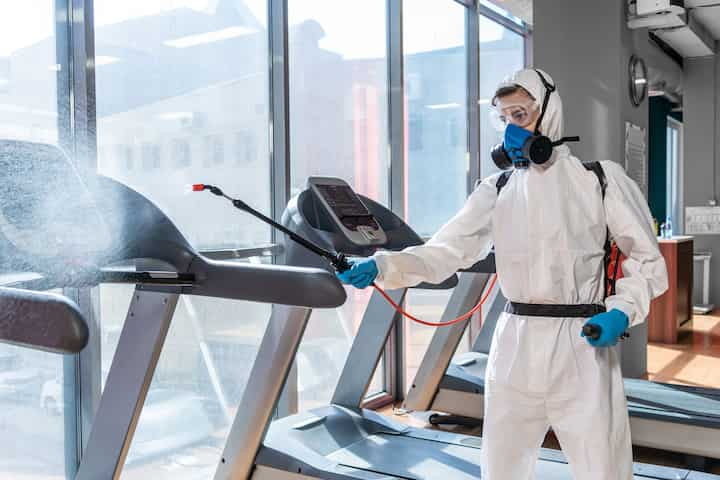How to clean black mold from drywall
The presence of black mold on drywall can be an alarming sight for homeowners, as it is often a sign of poor air quality and the potential for health risks. Cleaning this type of mold from walls is not only necessary to maintain a healthy home environment, but also plays an important role in preventing further growth.
Identifying black mold on drywall
Black mold is a common problem in homes and is generally found growing on surfaces such as drywall. It typically appears black or greenish-black, but can also be gray or brown. The texture of the fungus varies from slimy to powdery and it may give off a musty odor. To detect black mold on drywall, look for discoloration in small patches or large colonies that grow together in an irregular shape. If touched, the area should feel damp because the mold needs moisture to survive and thrive.
Safety precautions for cleaning mold
Once the presence of black mold on drywall has been identified, taking appropriate safety precautions for cleaning is essential. Without protective measures, it can cause a variety of adverse health effects in humans and animals due to its allergenic or toxic properties. Thus, it is important to wear personal protective equipment (PPE) while working with contaminated surfaces such as gloves, face masks, eye protection, and respirators.
In addition to PPE, proper ventilation should be ensured when performing any type of hazardous work with mold-contaminated materials. This helps reduce exposure by removing airborne particles from the environment. It also prevents further contamination from spores that may have become aerosolized during clean up efforts. Furthermore, disposing of potentially infected materials safely is critical for limiting spread into unaffected areas. The best way to do this is by sealing them in plastic bags or containers before placing them in an outdoor trash receptacle.
Products needed to remove mold from drywall
When attempting to clean black mold from drywall, it is important to have the right supplies and tools on-hand. Many products are available for removing mold safely, including cleaners, protective gear, and specialized equipment.
The most essential supplies needed to remove mold from drywall include a cleaning agent specifically designed for killing fungi such as bleach or hydrogen peroxide; rubber gloves to protect skin; face mask to prevent inhaling spores; scrubbing brush; bucket of water for mixing solution; and rags or sponges for wiping down the surface. Some individuals may chose to use additional items such as respirator masks with replaceable filters and safety goggles if they wish to ensure greater protection against possible airborne contaminants.
Steps for removing black mold from drywall
When it comes to removing black mold from drywall, there are a few steps one should take. First and foremost, the area of affected drywall must be identified by sight or smell. Once this has been done, the next step is to isolate the area with plastic sheeting in order to contain any moisture or spores that could spread to other areas of the home. It is also important for individuals to wear protective gloves, masks and eye protection when dealing with black mold as these can help protect against skin irritation, breathing difficulties and even blindness if not handled properly.
The third step involves cleaning the affected area using a bleach-based solution mixed with warm water. This helps kill off any remaining live spores while softening up the growth so that it can be easily wiped away. After this is complete, allow the area to fully dry before proceeding onto further treatment options such as painting over top of the treated spot or replacing sections of damaged wall board altogether.
Prevention of future mold growth
Preventing the growth of black mold on drywall is essential for long-term home health and safety. There are several methods to reduce the likelihood of further mold growth in a particular area, such as controlling humidity levels, increasing air flow, regularly cleaning surfaces with an anti-fungal solution, and using mildewcides during construction or renovation projects.
In order to control humidity levels, it is important to install exhaust fans near sources of moisture like showers and bathtubs. If possible, use dehumidifiers in areas prone to high humidity. Additionally, cracks and holes should be sealed off in order stop dampness from seeping through walls or floors. Increasing air flow by opening windows can also help keep indoor spaces dryer which can discourage mold formation.
Cleaning surfaces regularly with non-toxic cleaners containing anti-fungal agents can help prevent future outbreaks of black mold. When undertaking any new building or remodeling project, mildewcides should be used on both interior and exterior surfaces to limit the spread of fungal spores that could lead to mold growth later down the line.
If you're looking for fast and reliable mold remediation services, look no further than the experts at Mold Remediation-Jackson MS! With years of experience and a commitment to the highest quality work, you can rest assured that your home or business will be free of harmful mold. Visit
https://www.moldremediation-jacksonms.com today to get in touch with one of our friendly representatives and to learn more about our services. Don't wait - take action today and get the mold remediation services you need.
